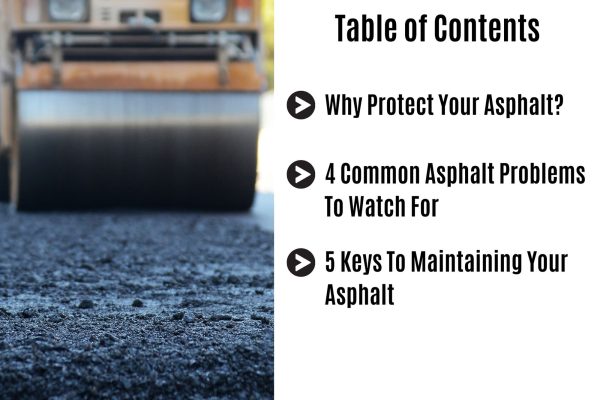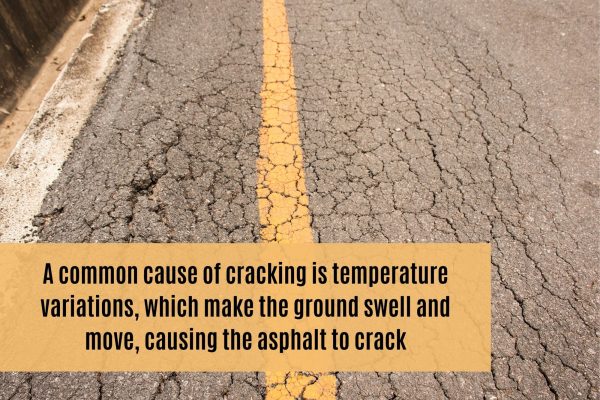If you own an asphalt driveway, parking lot, road, or other surface, you know that asphalt is a significant investment.
Asphalt doesn’t come cheap! A simple asphalt driveway could cost you several thousand dollars – not to mention parking lots or miles upon miles of roadway.
If you’ve invested money into your asphalt, you likely want to know how to care for it so it doesn’t deteriorate.
Good news! At General Pavement Management, asphalt maintenance is what we do, and we are here to tell you all about how to take care of your pavement.
Let’s get started!

Why Protect Your Asphalt?
First of all, why protect your asphalt?
We already mentioned the money factor. Brand new asphalt is quite expensive, so it can save you thousands to keep your asphalt in good shape. Whenever you are dealing with a large investment, you want to protect it.
But there are other reasons to keep your asphalt in good repair:
- Safety: If you are a business owner, you may be held liable for accidents caused by a lack of pavement markings, uneven surfaces/potholes, snow and ice, or other issues with your pavement. Keeping your asphalt in good condition cuts down on accidents and any legal issues that may ensue.
- Curb appeal: Whether you own a business with a parking lot or simply an asphalt driveway. Shoddy, pothole-filled asphalt doesn’t do much for the overall aesthetic of your property.
- Property value: If you take good care of your pavement, your property value can increase, partly due to the inherent quality and longevity of well-kept asphalt and partly due to increased curb appeal.
- Longevity: Pavement longevity increases with proper care, which means you won’t need to replace the whole of everything as quickly. So, while maintenance may be inconvenient at the moment, it pays off by saving you future stress.
Caring for your pavement pays off in the end! Next, we’ll look at some common asphalt issues to watch for. After all, you need to know what you are looking for in order to prevent it!
4 Common Asphalt Problems To Watch For
The first step to taking good care of your asphalt is knowing when it needs care.
>Here are 4 common pavement issues to watch for. If left for too long, these issues develop into serious problems that require additional repairs, so it’s best to nip them in the bud.
1 – Raveling
If you see lots of loose stones and bits of asphalt on top of your pavement, it may be raveling. Raveling is when the asphalt slowly crumbles up into tiny bits, leaving it rough and rocky.
Raveling normally happens when the liquid binder that holds asphalt together becomes brittle. Then, the asphalt is more prone to breaking, and the weight of traffic crumbles it up little by little.
2 – Cracking
Various things may cause asphalt cracks. One common cause is temperature variations, which make the ground swell and move, causing the asphalt to crack. Water worsens the issue by getting into the fissures, compromising the base layer, or freezing and expanding inside the crack.

3 – Alligatoring
“Alligatoring” is when a series of small cracks form in a sort of alligator skin pattern. Alligatoring is almost always a sign that your subgrade has problems.
Normally, alligatoring is caused by water seeping into small cracks in the pavement and slowly weakening the subgrade. This causes the pavement to become unstable and start cracking.
4 – Potholes
Nobody likes a jarring pothole! Various factors can cause potholes:
- Subgrade weakened due to moisture
- Asphalt that was never properly compacted
- Alligatoring left unattended
Potholes may be the most annoying type of asphalt flaw, and they only get larger if not taken care of, so it’s best to fix them ASAP!
Of course, not all asphalt problems are visually obvious at first. You should still implement good maintenance practices, even if your asphalt looks perfect.
5 Keys To Maintaining Your Asphalt
There are lots of issues your asphalt pavement could develop. But the good news is that you can take easy, practical steps to prevent them.
At General Pavement Management, that’s what we do! We are about to share 5 keys to asphalt maintenance so you can keep your pavement in good condition.
But before we do, we must understand what keeps asphalt “healthy.” Two main factors come into play:
-
A solid subgrade
The subgrade is the foundational layers of dirt and gravel below the asphalt.
Your asphalt needs a solid foundation to hold it up, so your subgrade matters. The key to keeping your subgrade solid (other than quality construction) is keeping water from penetrating it and washing parts of it away.
-
Maintaining flexibility in your pavement
Asphalt needs to stay flexible so it can bend and flex under heavy loads without cracking. If it becomes brittle, it will start breaking apart. For your asphalt to remain flexible, the liquid binder that holds it together must stay flexible and not dry out.
Flexibility and a solid subgrade are the goals.

Here’s how you can take care of these two factors and keep your asphalt healthy:
1 – Sealcoating
The #1 key to keeping your asphalt in good condition is sealcoating!
Sealcoating is a protective coating made of bituminous-based products or acrylics that you apply on top of your pavement to provide a layer of protection.
In other words, it’s a bit like a varnish for wood–it seals everything and protects it from the elements. This is useful because:
- It seals any minor cracks that may be forming, preventing them from growing. This ensures that no water gets down into the subgrade.
- It helps keep the asphalt binder from drying out and becoming brittle.
- It creates a beautiful, even black surface that looks like new asphalt!
Regular sealcoating is the #1 thing you can do to keep your pavement looking good and performing well for years.
If you want to know more about sealcoating, read our blog, Understanding the A-Z of Sealcoating.
2 – Crack/pothole filling
If cracks and potholes are left unattended, they will invariably get larger. That is because once they form, water can get inside and enlarge them, especially if the water freezes and expands inside the fissure.
The best thing to do with small potholes and cracks is to fill them up asap. That way, no water gets down inside and exacerbates the issues.

3 – Cleaning up spills
Motor oil, antifreeze, diesel, gas, and other harsh chemicals can be hard on pavement. Sometimes, they even weaken it enough to eventually cause potholes. It’s best to clean up major spills immediately so they don’t weaken the asphalt and cause deterioration.
4 – Line striping
Line striping doesn’t affect the lifespan of your actual pavement, but it’s essential to maintain it, too, as clear pavement markings are a crucial safety factor.
If your pavement markings are too worn to see, it may be time to restripe your parking lot.
Read our guide to pavement markings to learn more!
5 – Being proactive
Prevention is always better than cure! Minor problems eventually become major problems, so being proactive and fixing cracks, potholes, and other issues while they are small is key.
If you are a property owner with a lot on your mind, consider sitting down and making a maintenance plan for your asphalt, including regular pavement assessments and sealcoating, so these things don’t slip through the cracks.
Conclusion
Your pavement is a significant investment, so you want to take good care of it!
Thankfully, it isn’t too difficult to care for your asphalt. However, if you would like someone to take the load off your shoulders, give us a call here at General Pavement Management!
We offer a variety of asphalt paving services including:
Basically, if it has to do with pavement, we do it!
Contact GPM today to learn more about our asphalt paving services. We look forward to hearing from you!
